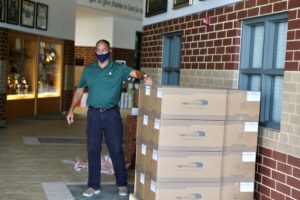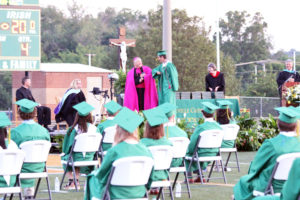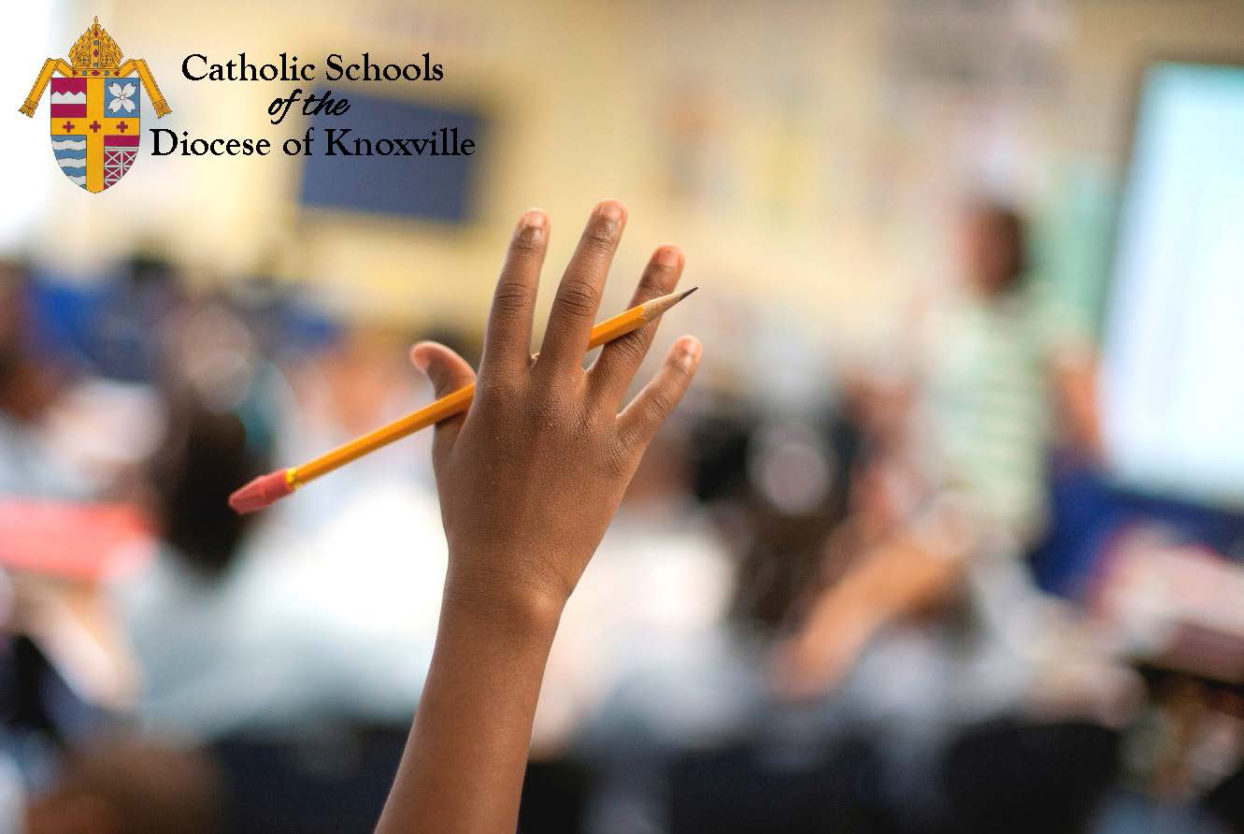COVID-19 protocols and procedures are greeting students, faculty at all 10 East Tennessee campuses
By Bill Brewer
Following a summer break of hope amid uncertainty, Diocese of Knoxville schools are welcoming students and faculty back into classrooms for the start of the 2020-21 academic year.
Bishop Richard F. Stika and Dr. Sedonna Prater, superintendent of schools for the diocese, made the announcement to return to in-class learning at all 10 schools in the diocese on July 17.
Classes are in session beginning Monday, Aug. 3.
 “We’re excited to begin our school year and open our classrooms to students and faculty,” Bishop Stika said. “Catholic schools and faith-based education offer families a unique environment to grow academically and spiritually. Our school leaders have worked hard to make sure that the learning environment is also safe for everyone who attends.”
“We’re excited to begin our school year and open our classrooms to students and faculty,” Bishop Stika said. “Catholic schools and faith-based education offer families a unique environment to grow academically and spiritually. Our school leaders have worked hard to make sure that the learning environment is also safe for everyone who attends.”
The diocese’s schools — Notre Dame High School, St. Jude, and Our Lady of Perpetual Help in Chattanooga; St. Dominic in Kingsport and St. Mary in Johnson City; St. John Neumann in Farragut; St. Mary in Oak Ridge; St. Joseph, Sacred Heart, and Knoxville Catholic High School in Knoxville — were forced to close in March due to public safety concerns brought on by the coronavirus pandemic.
While hopeful that the March 16 closure would be short lived, it soon became apparent the schools would be closed for the remainder of the school year as the COVID-19 outbreak spread.
Although classrooms were empty, diocesan administrators and faculty quickly shifted to an online learning program where students were able to continue their curriculum from their homes via computer programs.
Using that model, students were able to complete their studies and advance to the next grade level, and high school seniors were able to graduate.
That online learning model still will be offered to students and parents who wish to continue learning from home.
School leaders have developed procedures and protocols that will be enforced for on-campus learning to mitigate the safety risk and maximize the school experience for students’ return to classrooms.
Among the procedures for each school are:
- Infection-prevention education;
- Hygiene and sanitation, including safe-cleaning and disinfecting protocols at schools;
- Adherence to physical and social distancing;
- Facial coverings to be worn by students and faculty;
- Outdoor classrooms when possible;
- Suspension of off-campus field trips;
- Extracurricular activities limited to students who attend classes on campus.
The plan includes an option for families to elect online, at-home learning with the flexibility to change to traditional classroom learning for their children at any time during the fall semester.
“We have worked with families to help develop this plan,” Dr. Prater said. “Our parents are the first educators of their children, and we always work in partnership with them. Our school leaders and various task forces have worked diligently to develop operational plans that adhere to the scientific recommendations for the safest possible return of students and faculty to campus.”
Other provisions of the general health and well-being policy require all students to have up-to-date health exams and vaccinations, with schools requiring proof of both in accordance with Tennessee Department of Health regulations; parents of medically vulnerable students are encouraged to consult with their child’s health-care provider concerning his or her physical attendance at school; and an annual influenza vaccination is highly recommended for students, faculty, and staff.
Students’ health information is to be verified at least annually to ensure the information is current.
In addition, parents must notify the school if their child has a communicable disease, at which time the school will notify the parents of children who may have been exposed to a disease. Students’ anonymity will be maintained, and guidelines from the Tennessee Department of Health will be used in conjunction with the Family Educational Rights and Privacy Act (FERPA) and the Health Insurance Portability and Accountability Act (HIPAA).
Parents also must notify the school if their child has been diagnosed with COVID-19 or has been exposed to someone with the coronavirus and is in quarantine.
All employees, students, and visitors will be screened before entering the school building, including daily temperature screenings. School personnel will be looking for any COVID-19 symptoms, including cough, shortness of breath or difficulty breathing, chills, muscle pain, headache, sore throat, new loss of taste or smell, diarrhea, abdominal pain, malaise, fatigue, or rash.
Faculty and students will be excused from physical attendance at school if:
- They test positive for COVID-19; They have a fever of 100.4 degrees or higher;
- They exhibit two or more symptoms of COVID-19 according to the Centers for Disease Control and Prevention;
- An employee or student has been asked to quarantine because of exposure to COVID-19;
- There is a parental request for at-home learning, which is provided by the student’s school;
- And there are state or regional mandates to close school for on-site learning, at which time all diocesan schools will shift to the remote learning plan.

Orestes Pumariega, dean of students at Knoxville Catholic High School, receives a shipment of thousands of sanitizing wipes for the school ahead of students returning to class on Aug. 3
If a student is not able to be physically present at school because of COVID-19 symptoms or has tested positive for COVID-19, his or her siblings or other students living in the same household will transition to remote learning and will be asked to self-quarantine until meeting requirements for returning to school. The school will work with each family privately to create an educational plan for the duration of the self-quarantine.
Any student or staff member who shows symptoms consistent with COVID-19 during the day at school will be moved into a safe, private, isolated space for evaluation and pick-up. Those suspected of illness will be given a face shield in addition to their facial mask when interacting with others and will be sent home as quickly as possible.
Anyone assisting that individual also will wear additional personal protective equipment. The school will keep accurate records of all those in contact with the ill individual, and the isolation room will be disinfected frequently during the day.
The school will ensure the individual is safe and does not need emergency medical attention. If an individual appears seriously ill, the school will call 911 before calling the parents, guardian, or emergency contact.
Students and faculty may return to school once they satisfy any of these guidelines:
- A health-care provider confirms the individual’s illness is not due to COVID-19 because another explanation is identified (diagnoses of upper respiratory tract infection, pneumonia, and viral illness do not exclude the diagnosis of COVID-19 and shouldn’t be considered as adequate to return to school);
- Individuals are required to remain out of school until they haven’t had a fever for at least 72 hours without fever-reducing medication and respiratory and other symptoms have improved for at least 72 hours (testing for COVID-19 is not a mandatory requirement to return to school);
- If a person has been exposed to COVID-19, he or she must adhere to complete isolation for a minimum of 14 calendar days or he or she has been released from a health-care provider to return to school;
- And if a person has tested positive or has a pending test for COVID-19 but are asymptomatic, he or she may return to school after 14 calendar days or when he or she has been released from a health-care provider.
The school will notify parents of students who may have been exposed to the coronavirus. Confidentiality of the individual will be maintained unless there is a need to selectively identify him or her for contact tracing by the health department. The school also will have to assist the local health department in identifying contacts of the infected individual. Contacts will have to self-quarantine for 14 days from their last contact with the infected individual.
And while the confidentiality of the individual will be kept, the school will communicate to the school community at large that there has been a confirmed case of COVID-19 within the school.
“This communication will be completed to maintain trust within our communities, as well as to better protect our communities and their extended families,” the diocesan schools office stated.

Bishop Richard F. Stika and a Knoxville Catholic High School senior greet each other by bumping elbows during the KCHS graduation on June 19. Watching are from left, Father David Boettner, rector of the Cathedral of the Most Sacred Heart of Jesus, Dr. Sedonna Prater, KCHS academic dean Jane Walker, and KCHS president Dickie Sompayrac.
The 10 diocesan schools are being encouraged to provide outdoor classrooms as much as possible and to use large outdoor spaces for instruction, physical activity, and eating. And standard protocols in place for the school day will also be in place for gatherings, extracurricular activities including athletic events, plays, concerts, and other activities.
Spectators for athletic events will abide by local regulations and the standard protocols in place during the school day.
And families who choose at-home learning for their students instead of the traditional classroom setting will not be allowed to participate in extracurricular activities such as athletics, academic clubs, and performing arts like band, theater, and chorus. This does not apply to students in quarantine.
“(The protocols and procedures provide) the framework to plan and implement a safe, efficient, re-entry in our Catholic schools. It is important to realize that it is informed by evidence and global best practices, but it is limited by the boundaries of scientific knowledge about COVID-19 and its impact on our communities. Therefore, it is necessary to recognize that there is insufficient data to make recommendations that entirely remove risk from returning to school. It is also likely that as more information is acquired, plans will evolve,” the diocesan schools office stated.
“Our schools are committed to using all available information to make the best-informed decisions for our students and families regarding safety procedures. Please know that we are committed to monitoring and adjusting these plans accordingly. It is our intent to review protocols every two weeks, and we will inform our communities when any adjustments are made,” it further stated.
While cases of COVID-19 have leveled off and even decreased in parts of the United States that reported high numbers in the spring, case numbers have increased in other parts of the country, including the Southeast. COVID-19 cases in Tennessee have been escalating as medical researchers race to find a vaccine.
The diocese followed public-health mandates in March by closing churches to public Masses and closing schools, which led to the at-home-learning program. Churches reopened to public Masses on the weekend of Pentecost, May 30-31, and at the time it was hoped schools could reopen with the new academic year.
“While there may still be levels of uneasiness or uncertainty, we can say with great confidence that we will face these challenges as a community of faith. ‘The Holy Spirit upsets us because it moves us, makes us walk, pushes the Church forward,’ Pope Francis said. Let us all look for moments of grace as we enter this school year. May Our Lady shower her blessings on our school communities,” the diocesan schools office stated.
School Calendar
- Monday, Aug. 3: First day of 2020-21 academic year.
- Wednesday, Aug. 19: first at-home learning day.
- Wednesday, Sept. 16: second at-home learning day.
- Wednesday, Oct. 14: third at-home learning day.
- Wednesday, Nov. 11: fourth at-home learning day.
- Nov. 25-29: Thanksgiving break.
- Nov. 30-Dec. 4: week of at-home learning.
- Monday, Dec. 7: Christmas break begins.
- Tuesday, Jan. 5: spring semester begins.

